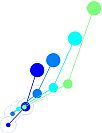Foraging is a widespread behavior, and being part of a group may bring several benefits compared to solitary foraging, such as collective pooling of information [1]. Often theoretical models of collective behavior use coarse-grained representations, or are too complex for analytical treatment, and generally do not take into account the effects of noise and uncertainty. This calls for the development of a mechanistic, analytically tractable, and stochastic framework to study the underlying processes of social foraging. Based on an evidence accumulation framework with two agents [2], we further developed a model of patch-leaving decisions in larger groups, with various information interactions (diffusive, pulsatile, counting, reward). Studying a two-armed bandit problem situation [3], where agents evolve between two patches of different qualities, enables quantifying the impact of social information on emergent collective properties such as cohesion, accuracy, and decision speed. First, we show theoretical results that enable quantifying the effects of social information on the group's behavior. Second, we show how this model can be applied to reproduce and analyze real data of a virtual experiment with five human subjects. This enables selecting which underlying mechanisms are the most likely to explain the data. In particular how social information is integrated, through decision biasing or value shaping processes.
References
[1] S Dall, L Giraldeau, O Olsson, J Mcnamara, and D Stephens. Information and its use by animals in evolutionary ecology. Trends in Ecology & Evolution, 20(4):187–193, April 2005.
[2] Subekshya Bidari, Ahmed El Hady, Jacob D. Davidson, and Zachary P. Kilpatrick. Stochastic dynamics of social patch foraging decisions. Physical Review Research, 4(3):033128, August 2022.
[3] Juliano Morimoto. Foraging decisions as multi-armed bandit problems: Applying reinforcement learning algorithms to foraging data. Journal of Theoretical Biology, 467:48–56, April 2019.

 PDF version
PDF version
